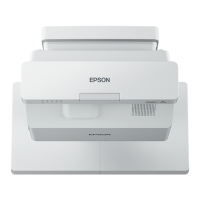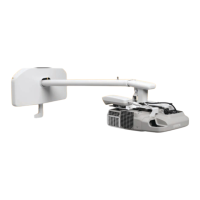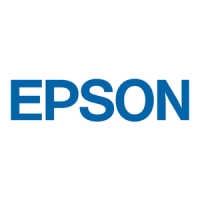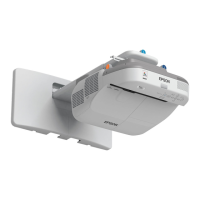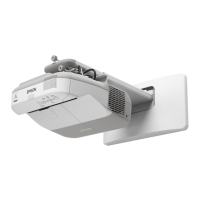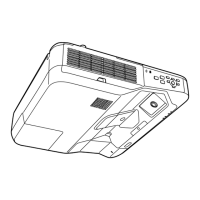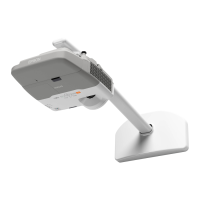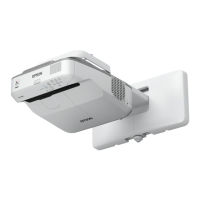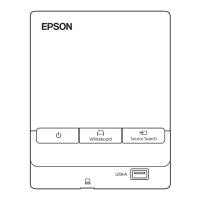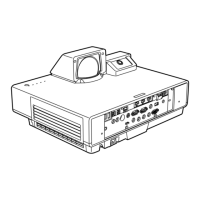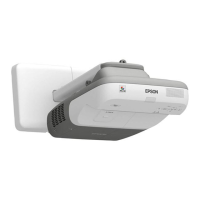Do you have a question about the Epson BrightLink 710Ui and is the answer not in the manual?
Details the unique functions, high-resolution system, and flexible connectivity of the projector.
Lists all the parts included in the projector box with illustrations.
Lists necessary additional components for connecting various video and audio devices.
Lists optional accessories and replacement parts for the projector with part numbers.
Provides information on the projector's warranty and how to register the product online.
Lists resources for obtaining quick help and additional information about the projector.
Identifies components on the front and side panels of the projector.
Identifies components on the top and side panels of the projector.
Identifies all input/output ports and connectors on the projector's back panel.
Identifies mounting holes and sensors located on the projector's base.
Illustrates and labels the buttons on the projector's control panel.
Illustrates and labels all buttons and features of the projector's remote control.
Identifies the components of the interactive pens and the pen tray.
Identifies the parts and ports of the projector's touch unit.
Provides guidelines and considerations for selecting an optimal location for projector installation.
Guides users on connecting the projector to various input sources and output devices.
Step-by-step instructions for connecting computers via USB, VGA, and HDMI.
Instructions for connecting various video devices like HDMI, MHL, Component, and Composite sources.
Step-by-step guide for replacing batteries in the projector's remote control.
Instructions on how to install batteries into the interactive pens.
Details how to connect and set up the projector for projection via a wired network connection.
Explains how to set up and connect the projector for wireless projection using a LAN module.
How to connect smartphones or tablets wirelessly using the Epson iProjection app and QR code.
How to configure security settings (WPA2-PSK, etc.) for wireless network connections.
Step-by-step guide on how to power on the projector correctly.
Instructions on the proper procedure for turning off the projector.
How to correct image distortion and ensure a rectangular projection using various settings.
How to adjust the projector's focus lever to sharpen the projected image.
Guidelines for operating the projector using the remote control, including range and angles.
How to select different color modes to optimize image quality for various environments.
Explains the different interactive modes: whiteboard, annotation, and PC interactive.
Instructions on how to use the projector's interactive pens for annotation and control.
Steps for calibrating the interactive pens to ensure accurate cursor positioning.
How to use finger touch for interactive functions after installing the Touch Unit.
Connecting a computer and installing software for interactive features like annotation.
How to split the screen and use interactive features with two sources simultaneously.
Adjusting settings like brightness, contrast, and color for optimal image quality.
Customizing input signal settings like resolution, aspect ratio, and tracking for optimal display.
Customizing features like geometry correction, zoom, and volume through the settings menu.
Customizing advanced setup features, including interactive functions and display options.
Configuring network settings for monitoring, control, and wireless communication.
Adjusting settings to save power, such as sleep mode and brightness levels.
General guidelines for keeping the projector in optimal working condition.
Procedures for cleaning and replacing the projector's air filter and vents.
Guide on how to replace batteries in the projector's remote control.
Instructions for replacing damaged or worn hard pen tips.
Guidelines for safely packing, shipping, or storing the projector.
Basic troubleshooting steps for common projection issues, including checking indicator lights.
Interpreting the meaning of projector indicator lights and their associated solutions.
Troubleshooting steps for issues related to projected images and audio output.
Steps to take if the projector displays no image or a black screen.
Solutions for when the "No Signal" message is displayed on the screen.
How to fix projected images that are not evenly rectangular.
Troubleshooting steps for issues related to audio output or volume.
Troubleshooting common issues encountered with the projector's interactive system.
Troubleshooting steps if the interactive pens are not functioning correctly.
How to fix inaccurate pen positioning relative to the mouse pointer.
Lists general technical details of the projector, including display type, resolution, and lens specifications.
Details the type, power consumption, output, and life of the projector's laser light source.
Lists compatible refresh rates and resolutions for various video display formats.
Outlines the system requirements for using the projector's USB Display software.
Crucial safety precautions for using the projector, including laser and electrical hazards.
Safety instructions related to the projector's Class 1 laser product compliance.
General safety guidelines for setup, usage, and maintenance to prevent injury or damage.
Regulatory information regarding FCC compliance for US users.
Details the unique functions, high-resolution system, and flexible connectivity of the projector.
Lists all the parts included in the projector box with illustrations.
Lists necessary additional components for connecting various video and audio devices.
Lists optional accessories and replacement parts for the projector with part numbers.
Provides information on the projector's warranty and how to register the product online.
Lists resources for obtaining quick help and additional information about the projector.
Identifies components on the front and side panels of the projector.
Identifies components on the top and side panels of the projector.
Identifies all input/output ports and connectors on the projector's back panel.
Identifies mounting holes and sensors located on the projector's base.
Illustrates and labels the buttons on the projector's control panel.
Illustrates and labels all buttons and features of the projector's remote control.
Identifies the components of the interactive pens and the pen tray.
Identifies the parts and ports of the projector's touch unit.
Provides guidelines and considerations for selecting an optimal location for projector installation.
Guides users on connecting the projector to various input sources and output devices.
Step-by-step instructions for connecting computers via USB, VGA, and HDMI.
Instructions for connecting various video devices like HDMI, MHL, Component, and Composite sources.
Step-by-step guide for replacing batteries in the projector's remote control.
Instructions on how to install batteries into the interactive pens.
Details how to connect and set up the projector for projection via a wired network connection.
Explains how to set up and connect the projector for wireless projection using a LAN module.
How to connect smartphones or tablets wirelessly using the Epson iProjection app and QR code.
How to configure security settings (WPA2-PSK, etc.) for wireless network connections.
Step-by-step guide on how to power on the projector correctly.
Instructions on the proper procedure for turning off the projector.
How to correct image distortion and ensure a rectangular projection using various settings.
How to adjust the projector's focus lever to sharpen the projected image.
Guidelines for operating the projector using the remote control, including range and angles.
How to select different color modes to optimize image quality for various environments.
Explains the different interactive modes: whiteboard, annotation, and PC interactive.
Instructions on how to use the projector's interactive pens for annotation and control.
Steps for calibrating the interactive pens to ensure accurate cursor positioning.
How to use finger touch for interactive functions after installing the Touch Unit.
Connecting a computer and installing software for interactive features like annotation.
How to split the screen and use interactive features with two sources simultaneously.
Adjusting settings like brightness, contrast, and color for optimal image quality.
Customizing input signal settings like resolution, aspect ratio, and tracking for optimal display.
Customizing features like geometry correction, zoom, and volume through the settings menu.
Customizing advanced setup features, including interactive functions and display options.
Configuring network settings for monitoring, control, and wireless communication.
Adjusting settings to save power, such as sleep mode and brightness levels.
General guidelines for keeping the projector in optimal working condition.
Procedures for cleaning and replacing the projector's air filter and vents.
Guide on how to replace batteries in the projector's remote control.
Instructions for replacing damaged or worn hard pen tips.
Guidelines for safely packing, shipping, or storing the projector.
Basic troubleshooting steps for common projection issues, including checking indicator lights.
Interpreting the meaning of projector indicator lights and their associated solutions.
Troubleshooting steps for issues related to projected images and audio output.
Steps to take if the projector displays no image or a black screen.
Solutions for when the "No Signal" message is displayed on the screen.
How to fix projected images that are not evenly rectangular.
Troubleshooting steps for issues related to audio output or volume.
Troubleshooting common issues encountered with the projector's interactive system.
Troubleshooting steps if the interactive pens are not functioning correctly.
How to fix inaccurate pen positioning relative to the mouse pointer.
Lists general technical details of the projector, including display type, resolution, and lens specifications.
Details the type, power consumption, output, and life of the projector's laser light source.
Lists compatible refresh rates and resolutions for various video display formats.
Outlines the system requirements for using the projector's USB Display software.
Crucial safety precautions for using the projector, including laser and electrical hazards.
Safety instructions related to the projector's Class 1 laser product compliance.
General safety guidelines for setup, usage, and maintenance to prevent injury or damage.
Regulatory information regarding FCC compliance for US users.
| Matrix type | 3-panel (p-Si TFT active) |
|---|---|
| Native aspect ratio | 16:10 |
| Projection technology | 3LCD |
| Contrast ratio (dynamic) | 2500000:1 |
| Contrast ratio (typical) | - |
| Screen size compatibility | - \ |
| Projector native resolution | WUXGA (1920x1200) |
| Keystone correction, horizontal | -3 - 3 ° |
| Service life of light source | 20000 h |
| Service life of light source (economic mode) | 30000 h |
| Placement | Ceiling, Wall |
| Product type | Short throw projector |
| Product color | White |
| Cable lock slot | Yes |
| Market positioning | Short throw |
| Cable lock slot type | Kensington |
| Mac operating systems supported | Mac OS X 10.10 Yosemite, Mac OS X 10.11 El Capitan, Mac OS X 10.9 Mavericks |
| Windows operating systems supported | Windows 10, Windows 10 Education, Windows 10 Education x64, Windows 10 Enterprise, Windows 10 Enterprise x64, Windows 10 Home, Windows 10 Home x64, Windows 10 IOT Core, Windows 10 Pro, Windows 10 Pro x64, Windows 7, Windows 7 Enterprise, Windows 7 Enterprise x64, Windows 7 Home Basic, Windows 7 Home Basic x64, Windows 7 Home Premium, Windows 7 Home Premium x64, Windows 7 Professional, Windows 7 Professional x64, Windows 7 Starter, Windows 7 Starter x64, Windows 7 Ultimate, Windows 7 Ultimate x64, Windows 7 x64, Windows 8, Windows 8 Enterprise, Windows 8 Enterprise x64, Windows 8 Pro, Windows 8 Pro x64, Windows 8 x64, Windows 8.1, Windows 8.1 Enterprise, Windows 8.1 Enterprise x64, Windows 8.1 Pro, Windows 8.1 Pro x64, Windows 8.1 x64 |
| 3D | No |
| Supported video modes | 1080p |
| Analog signal format system | NTSC, NTSC 4.43, PAL, PAL 60, PAL M, PAL N, SECAM |
| Supported graphics resolutions | 1920 x 1200 (WUXGA) |
| Ethernet LAN (RJ-45) ports | 1 |
| RMS rated power | 16 W |
| Noise level | 38 dB |
| Noise level (economic mode) | 27 dB |
| Operating temperature (T-T) | 0 - 45 °C |
| Throw ratio | 0.22 - 0.37:1 |
| Fixed focal length | 4.2 mm |
| Focal length range | - mm |
| Power source | AC |
| AC input voltage | 100 - 240 V |
| AC input frequency | 50 - 60 Hz |
| Power consumption (standby) | 2 W |
| Power consumption (typical) | 448 W |
| Power consumption (PowerSave) | 348 W |
| HDMI ports quantity | 3 |
| Serial interface type | RS-232 |
| USB 2.0 ports quantity | USB 2.0 ports have a data transmission speed of 480 Mbps, and are backwards compatible with USB 1.1 ports. You can connect all kinds of peripheral devices to them. |
| S-Video inputs quantity | 0 |
| Depth | 439.42 mm |
|---|---|
| Width | 495.3 mm |
| Height | 172.72 mm |
| Weight | 11203 g |
